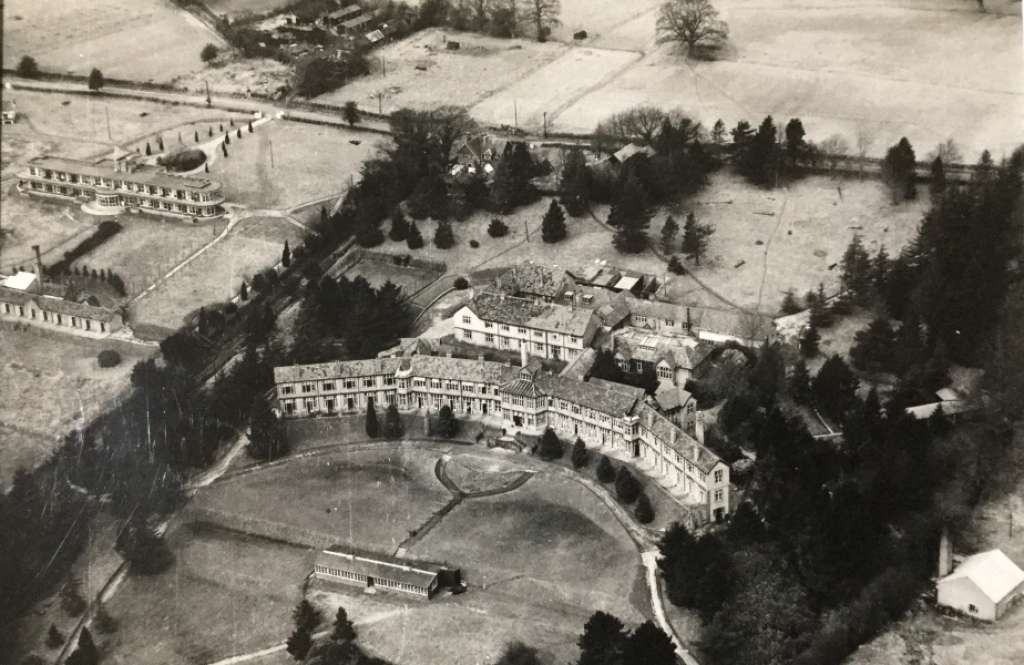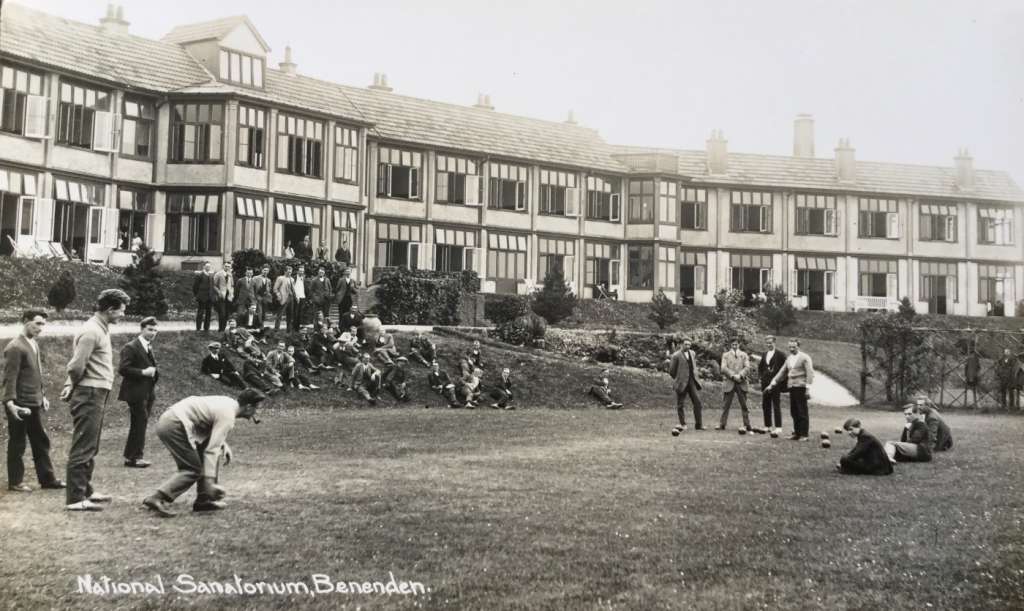PRESS RELEASE: Battle to save pioneering Royal Sanatorium built for Post Office Workers
16th November 2020
Don’t destroy it, convert it into handsome houses.
An imposing 1907 Sanatorium built under the patronage of King Edward VII and his sister for Post Office Union workers is under threat of total demolition. SAVE Britain’s Heritage is now championing its conversion into a series of terraced houses with new housing on land behind it.
The Benenden Tuberculosis Sanatorium near Tunbridge Wells is a remarkable example of Royal patronage that evolved in a wholly unexpected manner to produce two, not one, imposing sanitoriums at a time when Tuberculosis was known as the White Plague.
The design for the hospital was the winning entry in a design competition held under the patronage of Edward VII to build a new Tuberculosis hospital offering the latest medical treatments developed in Germany and Switzerland on the most advanced lines.
The sanatorium stands on a sunny south-facing slope in the Hamlet of East End, just two miles from the main village of Benenden, with magnificent views over an Area of Outstanding Natural Beauty – just what modern house builders dream of.
Yet a new draft Neighbourhood Development Plan currently out for consultation with Tunbridge Wells Borough Council has allocated the historic site for the construction of 49 new homes, referring to the historic sanatorium as a 'redundant hospital building’. Outline planning permission for demolishing the sanatorium was previously granted by the council to Benenden Hospital Trust in 2013.
SAVE calls on Tunbridge Wells Borough Council and Benenden Parish Council to amend the draft Neighbourhood Development Plan to acknowledge the Edwardian Sanatorium as a non-designated heritage asset of national significance that must be retained and converted as part of their site allocation for housing at the hospital site. Local people in the hamlet of East End where the hospital is situated have also strongly objected.
Marcus Binney, executive president of SAVE Britain’s Heritage says: “This is a prime candidate for converting the existing building into new houses with wonderful views across open countryside. We are appealing to the Secretary of State for Culture to list the Sanatorium on the basis that the historical importance of this royal commission was not understood.”
Ptolemy Dean, architect, SAVE committee member and Surveyor of the Fabric of Westminster Abbey, says: "The generous embrace of this healthy and deliberately restorative building, looking over beautiful Wealden countryside, remains as fresh and uplifting now as when it was originally conceived. Conversion into attractive and interesting houses will perpetuate this innovative vision in an environmentally appropriate and sustainable way."
Architectural historian Harriet Richardson, the nation’s most respected expert on the architecture and history of hospitals, says: “Of all the hospital buildings that I have been asked to comment on for their historic interest and as a candidate for listing, the former Benenden Sanatorium seems to me to be the clearest example where listing is fully justified. If it were not preserved, it would be a sad loss to our ever-dwindling heritage of health care buildings.”
SAVE argues that the new neighbourhood plan proposals for 49 homes are in conflict with the council’s own policies which are to support modest-scale housing development to meet local needs with a mix of well-designed, high quality, sustainable and affordable housing.
In contrast, proposals for the site drawn up by SAVE in July 2020 correspond with an existing planning permission for 24 dwellings on this site granted to Benenden Hospital Trust in 2013 which remains live and unimplemented. The SAVE proposals also accord with an aspiration set out in the Neighbourhood Development Plan supporting development “only on the footprint of the existing buildings.”
The sanatorium building is c.9500m2, which if demolished would have a huge carbon cost, at odds with the council’s declaration of a climate emergency on 17th July 2019.
SAVE has approached the hospital’s owners Benenden Health, based in York, with developers City & Country offering to acquire the site and conserve the hospital building, with new houses built behind. SAVE believes that in financial terms a heritage led housing scheme, retaining the Sanatorium can provide a return at least equal to clearance and new build.
WHAT YOU CAN DO
The public consultation on Benenden Parish Council’s Neighbourhood Development Plan, which supports the demolition of the sanatorium, is currently live and will remain open until 5pm on Friday 11th December 2020. You can submit your comments to the Borough Council in the following ways:
1. Online via the consultation portal.
2. By email to: neighbourhoodplans@tunbridgewells.gov.uk, filling out the response form, which you can download HERE.
3. By post to: Benenden NDP, Planning Policy, Planning Services, Tunbridge Wells Borough Council, Royal Tunbridge Wells, Kent TN1 1RS.
History
Benenden Sanatorium was lost from history because the winners of King Edward VII's 1901 design competition for a new English sanatorium, the leading doctor Arthur Latham and the architect Augustus William West, were passed over to build the first new Tuberculosis Hospital at Midhurst, and the commission given to a new architect.
Yet in a true display of British fair play, Latham and West were not left out in the cold. Indeed, it appears that the Royal Family came to their rescue, taking note of their original desire to provide treatment for the poorer elements of society.
Under the patronage of Princess Helena, the King’s third sister, a second new TB Hospital was commissioned at Benenden for the Post Office Workers Union under the newly established National Association for the Establishment of Sanatoria for Workers suffering from Tuberculosis. The Annual Report of the Medical Officer for the Local Government Board at the time, cites this as the first systematic attempt to provide a self-supporting sanatorium for the wage-earning classes in British history. The resulting sanatorium at Benenden was opened in 1907 to designs by Latham and West.
The plan of Benenden Hospital, like that at Midhurst, formed a gentle south facing arc. The main south front has long, low proportions similar to many early modern-movement buildings built between the wars. This undoubtedly gave it a streamlined proto-modernist look which was later heightened by the addition of Festival of Britain style balconies.
Latham and West were adamant that the sanatorium bedrooms should be on two levels only, to minimise exertion of patients from climbing stairs.
This was in contrast to many late 19th century sanatoriums on the continent which were multistorey – rather in the manner of grand hotels and spas in the mountains. Their explanation is both convincing and touching:
“Sanatorium patients are not capable of climbing many stairs... in raising the body vertically, an amount of work is done which is equal to that expended in moving the body twenty times the distance on level ground. In other words, a climb of 60 feet, or five stories, equals a walk of 1,200 feet along level ground.”
Latham and West also advocated a certain liveliness in the architecture - to make the building “as attractive and cheerful as possible, and avoid the dreariness associated with a hospital.”
ENDS
Note to editors
1. Queen Elizabeth the Queen Mother was patron of Benenden Sanatorium (1952 till her death) and came to the hospital on a two-hour visit, on 6th July 1950.
2. Footage captured by Britain Decays in 2020 shows the interiors of the Sanitorium, which was still in use until 7 years ago, in a reasonable state of repair, with original teak staircases and floors still intact.
3. The hospital was commissioned under the patronage of Princess Helena, King Edward VII’s sister and wife of Prince Christian of Schleswig Holstein, who played an important role on its evolution and completion. It therefore has the special imprimatur of a building in which both the King and his sister (Queen Victoria’s 5thchild) who played an important role in British public life. Benenden Hospital is Princess Helena’s most significant memorial.
4. The Sanatorium is part of Benenden private hospital, which operated on a neighbouring site as a clinic offering numerous treatments.
5. The SAVE proposals; presentation and layouts by Eva Palacios.
6. For more information and images contact Ben Oakley, Conservation Officer at SAVE Britain's Heritage: ben.oakley@savebritainsheritage.org/ 07388 181 181
7. SAVE Britain’s Heritage has been campaigning for historic buildings since its formation in 1975 by a group of architectural historians, writers, journalists and planners. It is a strong, independent voice in conservation, free to respond rapidly to emergencies and to speak out loud for the historic built environment.





